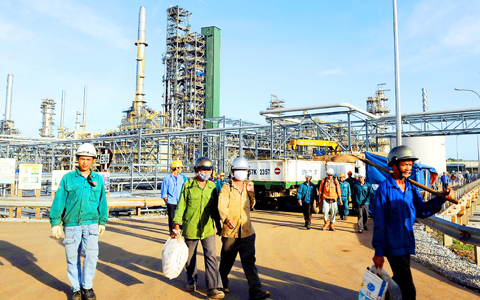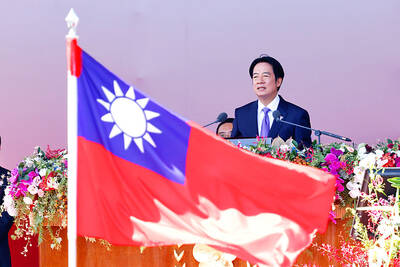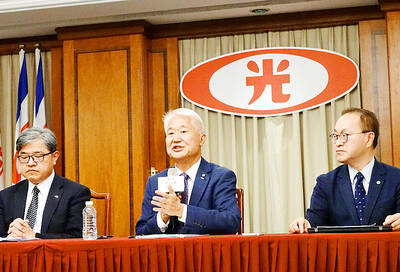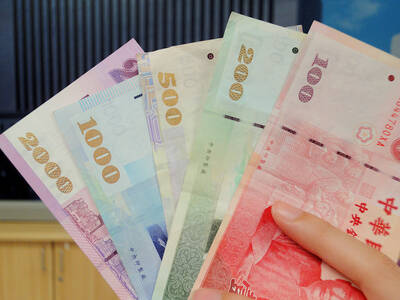Vietnam was to open its first oil refinery yesterday after more than a decade of delays, in what is being hailed as a significant moment in the country’s development and energy security.
Vietnamese Prime Minister Nguyen Tan Dung was expected to inaugurate the more than US$2.5 billion Dung Quat refinery yesterday evening live on nationwide television, an indication of its importance to the communist country.
Although Vietnam has considerable offshore oil reserves, it currently has to import all its petroleum products, costing the Southeast Asian nation hundreds of millions of dollars — a figure rising as energy consumption soars.

PHOTO: AFP
It spent US$10.88 billion importing refined products last year, official figures showed, while exporting US$10.45 billion crude oil.
State-owned PetroVietnam Group financed and will run the new facility, which is expected to churn out 6.5 million tonnes a year or 148,000 barrels per day — about 30 percent of the country’s needs.
PetroVietnam, which expects the refinery in the center of the country to be at full capacity from August, is designing another refinery in the north and has tentative plans for a third as Vietnam strives for energy autonomy.
“Dung Quat refinery is one of the most modern in the world,” said Dinh Van Ngoc, senior vice-president and chief executive of the arm of PetroVietnam that will run and manage the facility.
“It’s very meaningful for Vietnam, both practically and also spiritually — it can prove to the whole nation and Vietnamese people that Vietnam can build a refinery,” he said.
Dinh said the final figure for the cost of the refinery would be higher than US$2.5 billion but declined to be more specific.
The complex, built by an international consortium led by French oil services group Technip, has a long and checkered history.
When plans were first drawn up in the 1990s, the estimated cost was US$1.5 billion.
But several foreign backers pulled out, among them French giant Total, which baulked at the authorities’ insistence that the refinery be built in a mainly agricultural area with no tradition of heavy industry.
Critics and foreign investors argued that central Quang Ngai Province was too far from the offshore oil reserves in the south and from Ho Chi Minh City, Vietnam’s economically advanced commercial capital.
Experts said the government refused to have the first refinery anywhere else because it wanted to develop one of the poorest regions in the country.
The communist leaders also wanted to forge a new industrial area as a counterbalance to the capital Hanoi in the north and Ho Chi Minh City, formerly Saigon, in the south.
Authorities hoped the refinery and the industrial zone being built around it would create jobs for more than 20,000 people in the area, spurring the local economy.
New roads have been built in the zone and around the refinery, with a handful of new factories springing up, including at least one from South Korea.
Bruno Le Roy, the engineer managing the site for Technip, acknowledged it was “a political decision” to build the refinery in Quang Ngai Province, referring to the authorities’ determination to bring money to central Vietnam.
“I’ve seen in the last two years a big change in this area,” he said at the refinery, which covers 338 hectares of what was once farmland.

People can preregister to receive their NT$10,000 (US$325) cash distributed from the central government on Nov. 5 after President William Lai (賴清德) yesterday signed the Special Budget for Strengthening Economic, Social and National Security Resilience, the Executive Yuan told a news conference last night. The special budget, passed by the Legislative Yuan on Friday last week with a cash handout budget of NT$236 billion, was officially submitted to the Executive Yuan and the Presidential Office yesterday afternoon. People can register through the official Web site at https://10000.gov.tw to have the funds deposited into their bank accounts, withdraw the funds at automated teller

PEACE AND STABILITY: Maintaining the cross-strait ‘status quo’ has long been the government’s position, the Ministry of Foreign Affairs said Taiwan is committed to maintaining the cross-strait “status quo” and seeks no escalation of tensions, the Ministry of Foreign Affairs (MOFA) said yesterday, rebutting a Time magazine opinion piece that described President William Lai (賴清德) as a “reckless leader.” The article, titled “The US Must Beware of Taiwan’s Reckless Leader,” was written by Lyle Goldstein, director of the Asia Program at the Washington-based Defense Priorities think tank. Goldstein wrote that Taiwan is “the world’s most dangerous flashpoint” amid ongoing conflicts in the Middle East and Russia’s invasion of Ukraine. He said that the situation in the Taiwan Strait has become less stable

CONCESSION: A Shin Kong official said that the firm was ‘willing to contribute’ to the nation, as the move would enable Nvidia Crop to build its headquarters in Taiwan Shin Kong Life Insurance Co (新光人壽) yesterday said it would relinquish land-use rights, or known as surface rights, for two plots in Taipei’s Beitou District (北投), paving the way for Nvidia Corp to expand its office footprint in Taiwan. The insurer said it made the decision “in the interest of the nation’s greater good” and would not seek compensation from taxpayers for potential future losses, calling the move a gesture to resolve a months-long impasse among the insurer, the Taipei City Government and the US chip giant. “The decision was made on the condition that the Taipei City Government reimburses the related

FRESH LOOK: A committee would gather expert and public input on the themes and visual motifs that would appear on the notes, the central bank governor said The central bank has launched a comprehensive redesign of New Taiwan dollar banknotes to enhance anti-counterfeiting measures, improve accessibility and align the bills with global sustainability standards, Governor Yang Chin-long (楊金龍) told a meeting of the legislature’s Finance Committee yesterday. The overhaul would affect all five denominations — NT$100, NT$200, NT$500, NT$1,000 and NT$2,000 notes — but not coins, Yang said. It would be the first major update to the banknotes in 24 years, as the current series, introduced in 2001, has remained in circulation amid rapid advances in printing technology and security standards. “Updating the notes is essential to safeguard the integrity